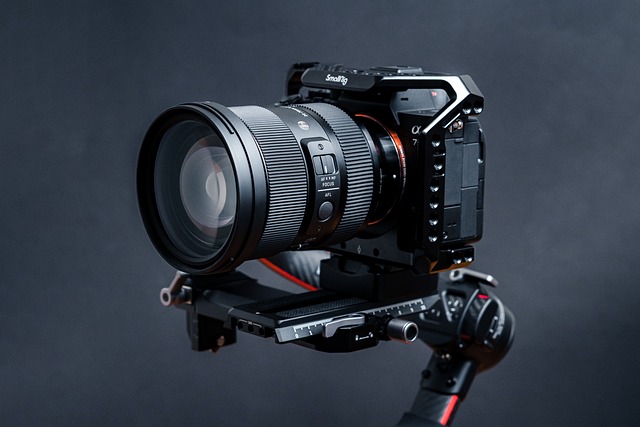The rapid growth of digital video content has transformed media consumption, driven by technological advancements and shifting viewer preferences. Efficient distribution methods are crucial as users expect seamless access to high-quality videos on demand. Traditional formats like DivX face compatibility challenges, especially when converting to widely supported formats like MOV for uninterrupted playback across different platforms and devices. Converting DivX to MOV offers a groundbreaking solution, streamlining distribution, enhancing accessibility, and fostering unity in the digital media landscape. This simple multi-step process has significantly impacted real-world video distribution, benefiting industries such as filmmaking, streaming, and education. As multimedia content becomes more intricate, easy video format conversions will become increasingly important, ensuring creators can focus on quality and engagement.
The digital video landscape is evolving rapidly, demanding efficient distribution methods. As content creators surge, ensuring compatibility across devices and platforms becomes a formidable challenge. This article explores a game-changer in digital video distribution: converting DivX to MOV format. We’ll delve into the rise of digital video, dissect compatibility issues, and uncover the revolutionary benefits of this process, along with a step-by-step guide and real-world applications. Discover how converting DivX to MOV streamlines accessibility and opens doors to enhanced multimedia experiences.
The Rise of Digital Video Content: A Growing Need for Efficient Distribution

In recent years, digital video content has experienced a dramatic surge in popularity, transforming the way we consume and share media. This shift is largely driven by advancements in technology and changing viewer habits. As more devices become capable of streaming high-quality video, consumers expect seamless access to their favorite shows, movies, and online content whenever and wherever they choose.
This growing demand for digital video has created a pressing need for efficient distribution methods. Traditional formats like DivX often present challenges when sharing or converting videos online, leading to compatibility issues. For instance, users may struggle to convert DivX files to more compatible formats like MOV for seamless playback across various platforms and devices. Therefore, finding effective solutions for digital video distribution is crucial to meet the evolving expectations of modern audiences.
Understanding DivX and MOV Formats: Compatibility Challenges

The digital video distribution landscape has seen its fair share of formats, with DivX and MOV being two prominent ones. However, understanding their compatibility challenges is key to navigating seamless video sharing. DivX, known for its high-quality compression, has been a favorite among users seeking efficient file sizes without compromising visual quality. On the other hand, MOV, developed by Apple, is native to macOS and iOS devices, offering excellent multimedia support within the Apple ecosystem.
While both formats have their strengths, converting DivX to MOV can be necessary for reaching a broader audience. This is especially true for content creators aiming to distribute their work across multiple platforms. Compatibility issues arise due to differing compression techniques and container formats, leading to potential playback problems or reduced quality when trying to play DivX videos on devices that primarily support MOV.
Introducing a Revolutionary Solution: Convert DivX to MOV

In today’s digital era, the need for seamless video distribution has never been more critical. Among the myriad formats and codecs available, DivX and MOV stand out as two powerful yet distinct standards. However, compatibility issues often arise when transitioning between these formats, creating a seemingly insurmountable barrier for content creators and distributors. To address this challenge, a revolutionary solution emerges: converting DivX to MOV.
This innovative approach promises to streamline video distribution by offering a straightforward and efficient method to convert videos from DivX format to MOV. By doing so, content can be seamlessly shared across various platforms and devices, eliminating compatibility headaches once and for all. The implications are significant, particularly for those involved in digital media production and dissemination, as it facilitates a more unified and accessible video landscape.
Benefits of Converting Video Files: Improved Accessibility and Compatibility

Converting video files, such as converting DivX to MOV, offers numerous benefits, particularly in terms of improved accessibility and compatibility. By changing formats, users can unlock a wider range of devices and platforms for viewing their content. For instance, MOV is a widely supported format across various operating systems and media players, ensuring that videos can be played seamlessly on computers, smartphones, tablets, and smart TVs without any compatibility issues.
This accessibility is especially valuable in today’s digital era where content needs to reach folks across multiple devices. Moreover, converting video files can enhance the overall user experience by providing better performance and higher quality playback. The process ensures that videos are optimized for specific devices, reducing buffering times and offering a smoother, more enjoyable viewing experience for all.
Step-by-Step Guide: Mastering the Conversion Process

Converting DivX to MOV is a straightforward process that can be achieved in several simple steps. First, download and install a reliable video converter tool that supports both formats. Popular choices include HandBrake and Format Factory. Next, launch the software and import your DivX file; most converters offer a drag-and-drop interface for easy navigation.
Once your file is added, select ‘MOV’ as the output format from the profile menu. Ensure you choose the appropriate settings based on your needs—for instance, bit rate and resolution. Finally, click ‘Convert’ to begin the process. Within moments, you’ll have a new MOV file ready for download or playback on your preferred devices.
Real-World Applications: Success Stories and Future Prospects

In the real-world application of digital video distribution, the ability to seamlessly convert DivX to MOV has proven to be a game-changer for many industries. This simple yet powerful conversion process allows for wider compatibility and better playback across various devices and platforms, addressing a significant pain point in the digital media landscape. For instance, professionals in filmmaking, streaming services, and educational institutions have embraced this technology to ensure their content reaches audiences without the need for complex format adjustments.
Looking ahead, the future prospects of this game-changer are equally promising. As multimedia content continues to grow in complexity and demand, the ability to easily convert video formats will become even more critical. The convenience and efficiency offered by DivX to MOV conversion tools enable content creators and distributors to focus on quality and engagement rather than technical barriers. This trend suggests a smoother, more unified digital video distribution experience for both producers and consumers alike.
The digital video landscape is evolving rapidly, and efficient content distribution is key to success. The rise of diverse video formats like DivX and MOV has created compatibility challenges, but innovative solutions such as converting DivX to MOV offer a game-changing approach. By mastering this conversion process, users can enjoy enhanced accessibility and compatibility, opening doors to a wider audience and fostering seamless digital video sharing. With real-world applications already demonstrating success, the future looks bright for this revolutionary solution in the ever-evolving world of digital video distribution.
